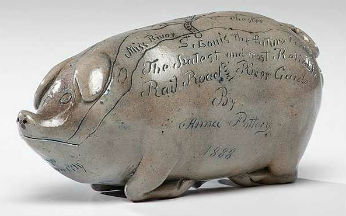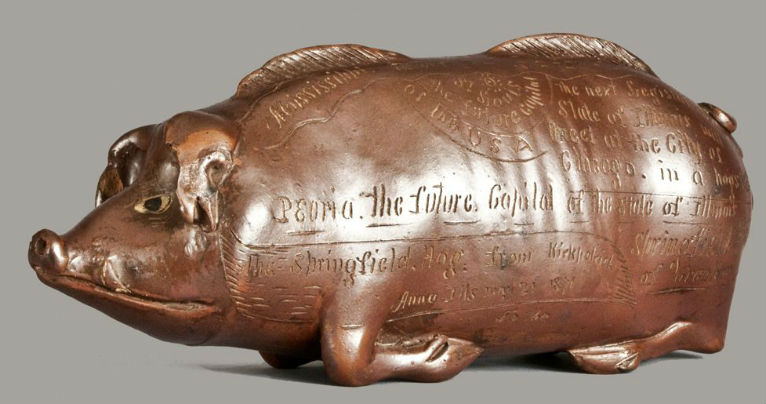
Terry Kovel, the grande dame and doyen of antiques and collectibles and editor of the longtime eponymous newsletter, once said of Anna Pottery pigs, “The first time I laid eyes on one I thought, ‘Why would anyone want to own one of these? They’re so ugly!’” She’s right, but therein lies their charm. Anna Pottery pigs – produced in the southern Illinois town of Anna from 1859 until its closing in 1890 – were made by brothers Cornwall (1814-1890) and Wallace Kirkpatrick (1828-1896). Their father Andrew was a potter and their brothers were potters, too.
The pigs were a small but imaginative segment of the Kirkpatricks’ overall business. The men were mainly purveyors of utilitarian stoneware: crocks, jugs, bricks, drain tiles, milk pans, reed-stem tobacco pipes and other functional pieces, plus giftware. But Anna Pottery was also known for fanciful wares, too, such as sculptural delirium tremens whiskey jugs, beautifully decorated vessels and flasks in the shape of pigs, the most common and most imaginative of all. Cornwall specialized in incised decoration, Wallace in molding. Each man was a businessman and a potter.
The most famous of the Anna Pottery pigs featured maps of railroads and often snarky, sarcastic references to social issues of the time, such as the temperance movement. Fortunately for the many collectors who prize the pigs, thousands were made. These hand-thrown, hand-molded pieces were often commissioned by businesses, such as saloons, railroad companies and glass and china merchants, for distribution to their clients as premiums, or as quirky advertisements. Others were given as presentation pieces, like the one that’s housed at Colonial Williamsburg.
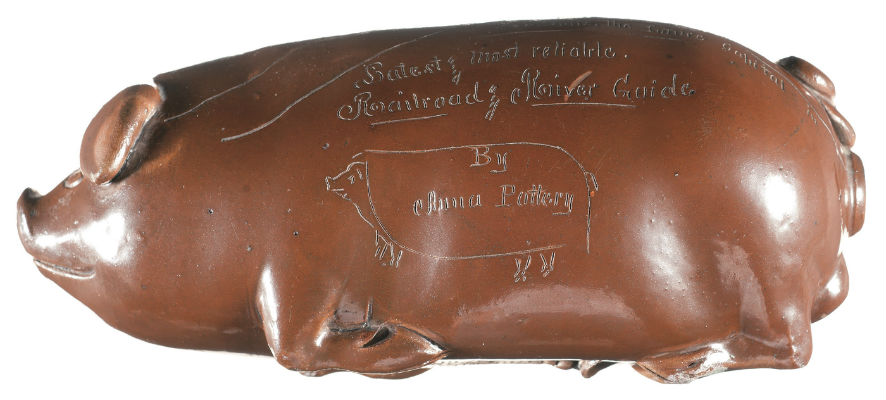
The incised railroad lines were common to most Anna Pottery pigs. These included stops for nearby places such as Chicago, Cairo, Mound City and “Porkopolis”, the nickname given to Cincinnati, as it was the nation’s pork processing center at the time. The written inscriptions, as mentioned, often had to do with alcohol consumption, and there is some debate as to whether the Kirkpatricks were teetotalers (the hole of the flask was usually located square at the pig’s anus, a possible reminder that drinking is a dirty pursuit) or social liberals, opposed to temperance.
“The fact that the pigs were flasks, meant to hold alcohol, tells me the Kirkpatrick brothers were pro-alcohol,” said Luke Zipp of Crocker Farm, the Maryland-based auction house specializing in American stoneware and redware. In March 2013, Crocker Farm set a new auction record for an Anna Pottery pig: $35,650 for an example known as the Springfield Hog. The previous record of $23,100 was also set by Crocker Farm, at its very first auction in July 2004. This past November, it sold a stoneware snake jug (not a pig) for $141,600, a world record for any Anna Pottery piece.
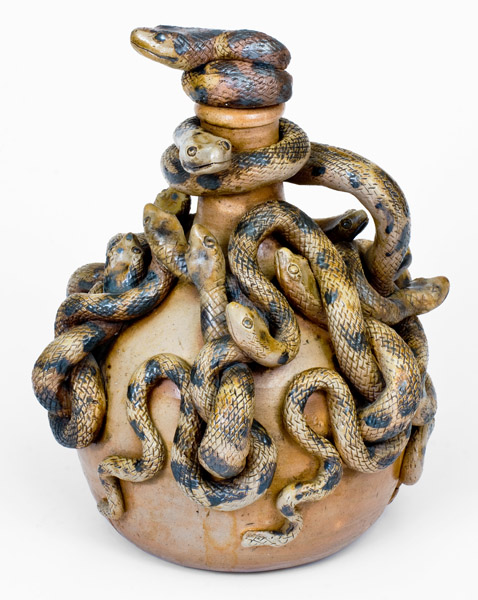
Zipp said of the pigs, “They’re just charming pieces of Americana, plus they were produced in the thousands, making them accessible and affordable to the collecting public. But they also carry enough snob appeal to have found their way into some of the world’s finest collections, in the Metropolitan Museum of Art, Colonial Williamsburg and other institutions. Also, the brothers make for an interesting back story. They were salesmen as well as potters. They rode the rails throughout the Midwest, gifting the pigs to clients and spreading goodwill along the way.”
Zipp also described the Kirkpatricks as “politically active” and they used the pigs as vehicles to express opinions of topical subjects of the day, not just temperance but politics and corruption. Several made references to figures such as Horace Greeley and Boss Tweed. One recurring issue was that of the nation’s capital. The Kirkpatricks argued it shouldn’t be in Washington, D.C., but in a more central, Midwest location, like Chicago or St. Louis. One pig has “St. Louis, the future capital” incised on the side, with an arrow pointing (sarcastically) to the rear of the pig.
As with all collectibles, condition and provenance count for a lot when considering an Anna Pottery pig for purchase. “Presentation pigs with papers and pedigree do particularly well,” said Jeffrey S. Evans, whose auction house in Virginia that bears his name has also handled numerous pigs over the years. “Historians and collectors like them as popular folk art collectibles, and there are a lot of them out there. The railroad lines, the temperance and other political messages, and just the overall graphic appeal of the pigs is what has helped them endure all these years.”
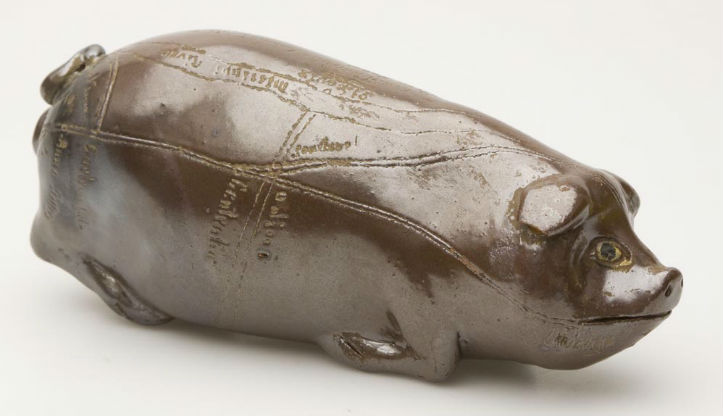
Anna Pottery conducted business out of a two-story frame building. The basement contained the clay-grinding operations (run by horsepower), the drying room had a hot-air furnace, and there were two kilns, each holding 2,000 gallons of ware (fired and burnt twice a week). The upstairs housed work rooms, for forming wares, plus additional storage space. In 1860, the company had 11 employees, producing 800,000 gallons of pottery annually. By the turn of the century, the public preferred the more modern and convenient tin and glass containers, and the pottery closed.
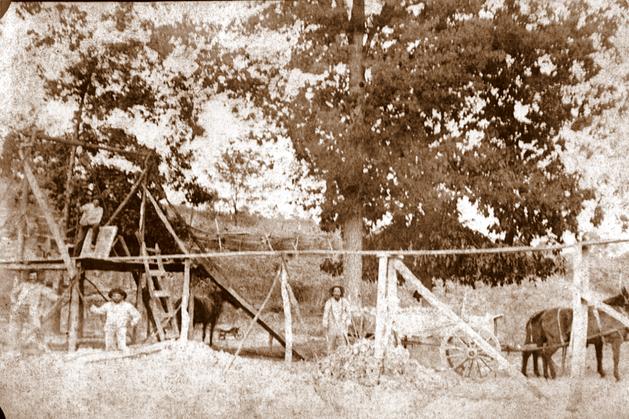
But while the utilitarian wares mass-produced by Anna Pottery have been mostly relegated to the dustbin of history, its whimsical and amusing offerings – especially the pigs – continue to have strong collector appeal. “They’re pigs, first and foremost, and people like pigs,” pointed out Wes Cowan of Cincinnati-based Cowan’s Auctions, which has probably sold the most high-dollar pigs of anyone outside of Crocker Farm. “The Kirkpatricks had a great sense of humor, and they were able to personally sell the pigs to retailers, who probably bought them by the barge load.”
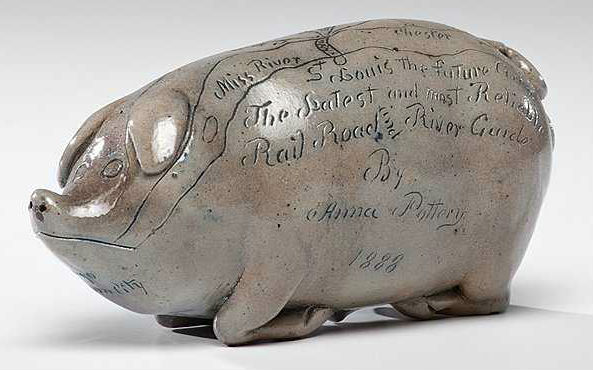
Cowan said the market for the pigs today is robust, especially for salt-glazed examples with cobalt-inlaid inscriptions, inlaid glass eyes, blue decorations or any combination thereof. “Stoneware hasn’t fallen off like many other mid-level antiques,” he said. “It’s possible to purchase a nice pig in the $2,500-$4,500 range, which is attractive to collectors.” He added condition issues, like nose and ear chips, can adversely affect prices. Luke Zipp pointed out that true Anna Pottery pigs must be signed, with identifiable penmanship and snout characteristics.


